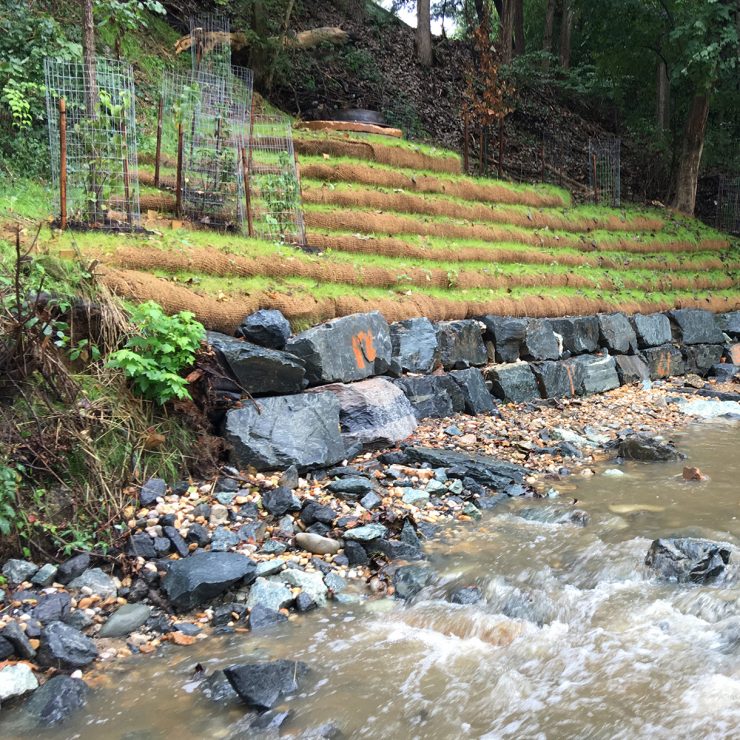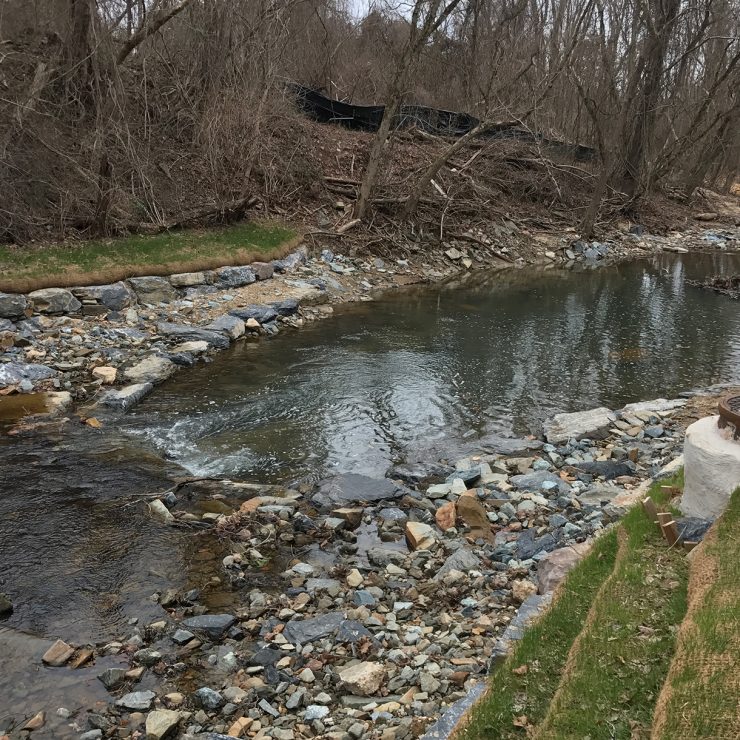By: Andrew T. Der, C.E.P.
The new federal “clean water rule” is less about clean (or dirty) water and more about simply where water is, or is not. Nor is it that new.
Everyone clamors for predictability and uniform definitions of regulated Waters of the United States (WUS), so why do they change? If they need fixing, were they broken?
One thing is evident. When a science-based topic is deliberated by those less immersed in the science, ultimately abstract concepts of good or bad are gradually attributed to what should primarily be a technical dialogue.
The Clean Water Act and Maryland
Those working in our industry are familiar with prominent 1972 Clean Water Act (CWA) amendments which have been the basis for many of the ways WUS are regulated at the site level. They include the U.S. Army Corps of Engineers (COE)-administered Section 404 waterway and wetland permitting process (jointly administered with a rigorous state program); Section 401 state Water Quality Certification (WQC) which goes with – and can veto – a 404 permit; Section 402 Phase I and II National Pollutant Discharge Elimination System (NPDES) stormwater General Construction and Municipal Separate Storm Sewer System (MS4) programmatic permits; and the Section 303 Total Maximum Daily Load (TMDL) program. (I should have given an abbreviation warning!)
They all reference and regulate WUS, unifying and catalyzing meaningful deliberation. What may get lost in the shuffle is that regardless of how WUS are defined, Maryland’s and the localities’ laws and regulations exceed them, while preserving preferential state rights as intended.
Anyone working in CWA-related disciplines needs to know the extent of site-level WUS limits – comprised of navigable water, open water, streams, and wetlands contiguous to these waters, both tidal and nontidal – but it doesn’t end at the COE permitting level. The Maryland Department of the Environment (MDE) additionally regulates the nontidal 100-year floodplain, 25-foot nontidal wetland buffer, 100-foot buffer to state-designated rare and sensitive waters and wetlands, and isolated waters not federally jurisdictional. MDE also regulates “non-COE”, or “non-fill”, activities in all waters such as vegetative clear-cutting and excavation.
Further, the Maryland Department of Natural Resources’ (DNR) groundbreaking Chesapeake Bay Critical Area law emplaces its own additional 100-foot buffer to waters, including wetlands, via delegated local planning overlays within 1000 feet from tidal waters. And outside of the Critical Area, DNR’s Forest Conservation Act, bypass-through delegated ordinances, adds water and stream setback buffers of usually 75 to 100 feet. These are further expanded by sensitive habitat, steep slopes, and erodible soils.
WUS have zero buffers from federal agencies.
COE-regulated activities also require the corresponding Section 401 WQC from the MDE, which certifies the federal Section 404 permit will not violate Maryland’s water quality standards – providing MDE (and every other state) with complete federal permit veto ability. Despite current media-reported executive branch intentions to potentially modify this process (regardless of whether good or bad), a substantial change to a federal act is not possible without Congress.
Moving on to stormwater management (SWM), Section 402 NPDES is the basis of Maryland’s SWM MS4 permits as well as the Construction General Permit Notice of Intent (NOI) process. As such, it also drives acceptable state SWM and erosion and sediment control (ESC) compliance. Current ESC and SWM criteria require contemporary best management practice (BMP) designs to disconnect stormwater runoff. This must be accomplished by environmental site design (ESD) to the maximum extent practicable (MEP) so that any water leaving post-development lands mimics “woods in good condition” – and is what the receiving WUS “sees”. This is huge.
But wait, there’s more. CWA Section 303 mandates TMDLs for WUS stream segments putting them on a pollution diet with the most recent being the Chesapeake Bay TMDL – the largest in the country – achieved by state and county Watershed Implementation Plan (WIP) compliance.
This layers on more state waters criteria even while its assumptions may not adequately account for Maryland’s other progressive criteria already in place prior to the WIP. In light of “pre-Bay TMDL” water quality management and restoration requirements coupled with a robust SWM law of ESD to the MEP, any further regulation of WUS could achieve a redundancy or even net gain with redevelopment of pre-regulation lands.
The Rules
Maryland has more than got it covered regardless of what the final federal rules are. The sky is not falling. Rather, our prominent challenge and lowest hanging fruit continues to be compliance with the contemporary criteria already in place and this is where our attention and efforts should focus the most.
Since other processes may key off of WUS limits by ripple effect, uniform federal rule-making is a good thing – and achieving consensus on what those are on the ground is the critical issue. In other words, how far up does it go and how wet does it have to be? That is key. Clarified and uniform WUS definitions were generically welcomed when the U.S. Environmental Protection Agency (EPA) proposed the 2015 federal rules. So what happened? And why change them again?
While the rule’s merits continue to be deliberated in all three branches of government, the jury appears to still be out on why the rules were changed.
Before the 2015 rules, the COE historically struggled to make practicable determinations of WUS limits based on policy, the ordinary high water mark, a generic 1986 waters definition, and a 1987 wetland delineation manual. This left some debates settled by the U.S. Supreme Court – somewhat reducing the COE’s jurisdiction. Among numerous rulings, two notable ones include are (1) the jurisdiction cannot extend to some ephemeral channels (“Rapanos”) and (2) the jurisdiction cannot extend to isolated waters (“SWANCC”).
The 2015 rules also reveal some confusion and potential for expanded federal jurisdiction beyond what may be viewed as technically substantiated or beyond what the Supreme Court intended. For example, certain ditches and isolated waters non-jurisdictional under Rapanos and SWAANC, respectively, can be subject to regulation. And some consider the primary 2014 scientific analysis used to technically document the basis for the 2015 rules to be incomplete and inadequate.
Despite stakeholder intentions to clarify vague definitions, some consider the 2015 rule interpretations of the terms tributary, neighboring, abutting, floodplain, and riparian area to be more vague in how they establish “nexus” – a term that can be subjective in the field and potentially allow more waters to come under federal authority than has been customary and predictable.
Predictability is something we all can agree is desperately needed.
Others assert that an unanticipated outcome of the 2015 rules is some stormwater BMPs and upland swales can be subject to WUS regulation, bringing stormwater management and local land use into the purview of a federal water permitting program.
What Now?
A myriad of lawsuits resulted in some courts overturning the 2015 rules in 24 states (not Maryland) in February 2018, rendering different definitions in different states. In addition to nationwide consistency, proponents of the September 2019 newly published rules expect they will likely refine the current 2015 rules to be more congruent with the courts as well as customary pre-2015 criteria and agency policy – and on a more global level, support the affirmation of federalism principles.
Meanwhile, legislators and stakeholders continue to clash over the clarity of water rules that may not be so clear. Courts in May and August 2019 overturned the 2015 rules in four more states and before we could find out if other courts might find this persuasive, the EPA and the COE jointly proposed in September the new rules which, in effect, more closely align with pre-2015 criteria.
Final rules are expected in the Federal Register with a 60-day comment period likely culminating at the end of November 2019. This will not affect the states where the courts already repealed the 2015 rules.
Will this change anything in Maryland and surrounding states?
Stay tuned.

